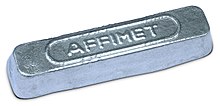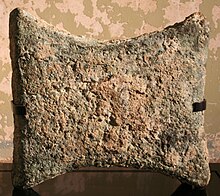Ingot (metal)

Ingots are metallurgically melted metal cast in standardized form .
Ingots as a product are solidified melts whose shape is not assigned to any other purpose than being an easily transportable and manageable intermediate stage for later use. The later, arbitrary usability compared to also traded molded parts cast directly at the hearth caused the bar shape. The bars are often referred to as ingots . The term ingot ( English generally for 'bar') is used in German as a technical term for bars made of semiconductor material, e.g. B. silicon is used.
history

Bars were already known as a useful means in prehistoric times. They were produced from copper , bronze , gold , silver , tin and other metals, often as an alloy specified by the ore extraction site .
By remelting the bars that were manufactured or traded in stock, cast parts with a predetermined shape could be produced far from where they were produced. In classical times these were not just weapons, but also statues and monuments. Without remelting, it was primarily copper or bronze ingots that could be made useful for a variety of purposes by purely mechanical cutting and subsequent manual processing ( forging ) (gold jewelry, bronze dowels, bronze sheets, eating utensils).
Bars made of gold or silver in particular were not only traded goods, but also a store of value. Long before the turn of the century, they were used for barter transactions and thus had a certain degree of coinage, especially in the cultural area around the Mediterranean . As a result of this function, the first coins were minted because they made them easier to handle for everyday purposes.
The ingot, as a step between the unshaped melt and a defined cast product, only gained greater and industrial importance with the beginning of iron smelting in Central Europe . Here, too, it was the transportable ingot that was brought into the valleys from ironworks built in the forests ( charcoal extraction ) around ore-rich areas, often remotely, to the water-powered forge hammers, rolling stands , rolling mills and foundries.
Bars as a means of payment and as an intermediate product
Precious metal bars
Bars in various forms were not only of early industrial importance, they have also been around since around 2000 BC. An early form of metallic money. In terms of currency history, precious metals in bar form can only be found in the vaults of central banks today. Gold and silver coins lost their internationally accepted function as current currency to cover the paper money in circulation until the first time after the Second World War. Both coins and bars made of precious metal are now collectibles for numismatists as well as stores of value for investors. As investment coins ( Krugerrand , coin bars and others) they are still minted, cast and sold today.
In international trading, standard bars are precious metal bars with an embossed weight and a guarantee of purity. The bars indicate the fineness, the manufacturer's brand, a serial number and the year of production. The fineness must be at least 995/1000 for gold , 999/1000 for silver and 999.5 / 1000 for platinum and palladium . The serial number is used to identify each bar and is entered in a directory by the producer. A standard gold bar (“good delivery bar”) has a nominal weight of 400 troy ounces (around 12.44 kg). However, the permitted fine weight of the gold standard bars can vary between 350 and 430 ounces (750 to 1100 troy ounces for silver).
Ingots of useful metals and their alloys
All useful metals and their alloys are manufactured as bars with different looks and weights, depending on the needs of further processing. Pig iron ingots for iron foundries make up the largest share . Bars made of aluminum and aluminum alloys are large-sized rolled or pressed bars as primary products for further processing into semi-finished products . Smaller bars, on the other hand, are used as input material for aluminum foundries. The bar shape is subject to certain modifications due to suitability for transport and customer requirements. Copper in the form of bars has been known since the early metallurgical period. The electrical industry still needs pure and pure copper bars. Heavy metal foundries melt down bars made of brass , gunmetal , bronze or other copper-based alloys. In practice, every useful metal is marketable in its pure form and as an ingot, as this is the only way to meet the alloying requirements of the casting consumer in the foundry. The various master alloys in ingot form facilitate this task .
The sale of bars in the field of aluminum alloys has been declining for years, as bulk consumers prefer liquid metal supplies for economic and ecological reasons (as of 2010).
Manufacturer
Ingots or ingots made of useful metals are produced by both primary and recycling smelters and put on the market. Manufacturers of precious metal bars ( refineries ) are subject to special requirements; in order to be marketable, their products require certification and an embossed producer's mark and hallmark . Well-known companies are Aurubis ( DE ), C. Hafner ( DE ), Cendres + Métaux ( CH ), DODUCO (DE), Engelhard Corporation ( US ), Heraeus (DE), Johnson Matthey ( UK ), Metalor (CH), Umicore ( BE ), Valcambi (CH), Heimerle + Meule (DE) and Argor-Heraeus (CH), Mint Austria (A), Ögussa (A) (not LBMA - listed). Degussa no longer produces gold bars because it ceded this branch of the company to Umicore and the brand name was sold to a precious metal dealer. Except for Ögussa and Mint Austria (produced by Argor-Heraeus), all of the above Company manufactures gold bars in accordance with the London Bullion Market Association's “ Good Delivery ” quality standard . Usually, all bar manufacturers listed by the London Bullion Market Association are accepted by almost all banks in the world.
Ingot and ingot weights
Useful metals
There are no weight specifications for bars made from molten metal. In the semi-finished production of non-ferrous metals , the weight of rolled aluminum billets can be up to 40 t, in the case of pressed billets ("round blanks") it is usually at least a few tons. Even higher weights are possible for rolled slabs in the steelworks. For consumption in foundries, one does not speak of ingots, but of ingots, which are manufactured as individual pieces divided by notches in a ingot casting machine or cut to size using the continuous casting process. Commercially available pig iron ingots can weigh up to 20 kg, while aluminum ingots of the same size weigh only a third of that. Large billets are poured off at the request of the consumer.
Precious metals
In the case of precious metals, one speaks uniformly of bars, the weight of which is largely standardized for platinum, palladium, gold and silver. Details of the bar weight are in kilograms, troy ounces and grams, in Asia also tola (11.664 g) and tael (37.4–37.8 g). In gold trading, the listed price is troy ounce (English troy ounce ) determined approximately 31.1035 g. Of the eight classic precious metals, only the common four gold , silver , platinum and palladium are generally traded in bar form, as the others ( ruthenium , rhodium , osmium and iridium ) would be too cumbersome due to the high melting point and thus the high energy consumption first transferred from the powder form customary in industry to bars, in order to then pulverize them again later, when they are used in industry. Rhodium has been available to capital investors since 2013 and iridium and ruthenium since 2016 in bar form. Osmium bars are made for collectors of samples of chemical elements .
photos
Antique copper bar ( ox skin bar ) from Kato Zakros , Crete . The bar has the shape of an animal skin, typical for the 2nd half of the 2nd millennium BC. Chr.
Katanga cross made of copper, 18th century
Pig iron ingot from the 19th century from Bergslagen , Sweden
Credit Suisse gold bars weighing one troy ounce
Gold bar weighing approximately 12.44 kg. Gold bars of this size are mostly only owned by central banks .
Iridium bar (1 troy ounce) in sealed transparent packaging as an investment item
Web links
Individual evidence
- ↑ London Bullion Market Association: see there: LBMA specifications
- ↑ London Bullion Market Association: LBMA Good Delivery Lists ( Memento of the original from January 17, 2013 in the Internet Archive ) Info: The archive link was inserted automatically and has not yet been checked. Please check the original and archive link according to the instructions and then remove this notice.
- ↑ London Bullion Market Association: LBMA Good Delivery Lists ( Memento of the original from January 17, 2013 in the Internet Archive ) Info: The archive link was inserted automatically and has not yet been checked. Please check the original and archive link according to the instructions and then remove this notice.
- ↑ Degussa is offering rhodium in bar form for the first time. Coin Week, February 7, 2013, accessed September 5, 2017 .
- ↑ Degussa offers bars made of iridium and ruthenium. Goldreporter.de, August 4, 2016, accessed September 5, 2017 .












